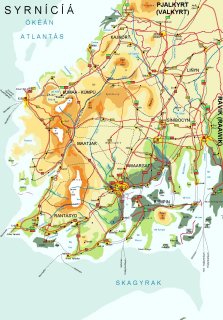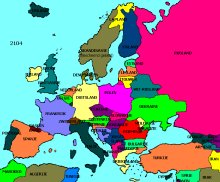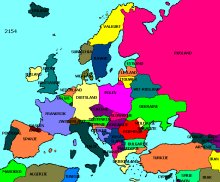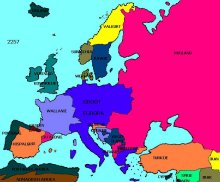2075 - 2153: protectorate Scandinavia
In 2075 the Third World War broke out, a nuclear war in which almost three billion people over the entire planet lost their lives. Many Western nations were turned into ruins by the end of the conflict in 2098. Among these nations were Norway and Sweden. The economy of these countries was irreparably damaged, and hundreds of thousands of Norwegians and Swedes had lost their homes and their jobs. In addition, a volcanic eruption in southern Norway in 2076 resulted in more loss of life, mainly due to heavy flooding. A large part of the surviving population migrated to the European continent in search for a better life. By 2103 the majority of the Norwegian and Swedish population had left their country. In 2104 the Norwegian and Swedish governments were dissolved, and the whole area was declared uninhabitable. In the north, the Sami people, who were accustomed to a harsh nomadic life, united themselves and founded their own state. The rest of the area was brought under surveillance of an international commission installed by the United Nations, which had a purely administrative function. However, as a result of the World War, the United Nations were faced with enormous problems all over the world, and the Scandinavian "protectorate" fell into oblivion. The administration was disbanded, but the remaining population lived in small secluded communities spread over the area that were fully self-supporting.
In 2140 Russia invaded Finland, and many Finns and Sami people fled westward, where they mixed with the Norwegian and Swedish communities that were dispersed over the area. In the course of time, bigger and tighter communities were established consisting of both original inhabitants and newcomers. A North-Scandinavian Germanic dialect, influenced by some Sami vocabulary, became the dominant lingua franca with which the different ethnic groups communicated with each other. One of the bigger and more successful communities had settled around the abandoned Norwegian town of Seljord, which was now developing into a flourishing administrative and commercial centre. The new city was called Jelnyr (Jelnur), a local dialect variant of Seljord. As the different communities grew, many of them started to set up trading relations and political and socio-cultural bonds. Eventually, this resulted in the creation of increasingly bigger overarching governances.
2153 - 2203: the Surnichian Aristocracy
In 2153, the different Scandinavian communities had grown out to three main regions with their own autonomous administration. On June 5th, the regions declared their independence from each other and three states, led by the heads of the largest local communities, were established: Surnichia (local name Syrnícíá), mainly consisting of Norwegians and Finns, Raawik (Råvik), mainly consisting of Swedes and Finns, and Valkurt (Valkyrt), mainly consisting of Sami. The aristocrat leaders of the three new states aimed to develop prosperous self-supporting nations that would always remain neutral in international conflicts. In the years after 2153, the aristocrat government of Surnichia reached full maturity, and the foundations were laid out for the extraordinary judicial and legislative system that Surnichia still maintains. The aristocrat leaders wished to take a completely neutral position in international conflicts. This was exactly the position of the Surnichian government during the Fifth World War, which broke out in 2175, after a number of member states of the European Union were united in the federal state of Greater Europe. One of the main goals of the union was cleansing Europe from the Jews, in revenge for the mass slaughter of Muslims in the Middle East by Israel. Heavy opposition came from EU-members that had not joined the federation, resulting in a military conflict across Europe and the Arab world. Large numbers of prosecuted Jews sought refuge within the borders of neutral Surnichia, where they found a new home.
Initially, Surnichia did not want any involvement with Greater Europe or any other part of the world. However, Surnichia's self-supporting economy was struggling more and more, because only a small part of the land was suitable for agriculture and because of lack of workers in the industrial sector. For these reasons, the government was forced to enter into international trading relations. The first trade union was between Surnichia, Raawik and Valkurt: the Scandinavian Economic and Political Association (SEPF). This union appeared not to be sufficient, and soon associations with the United Kingdom and Canada, among others, were initiated. When Wallania, one of the semi-autonomous states of Greater Europe, broke out of the European rule, friendly relations between Surnichia and Wallania were established. Around the year 2200 Wallania even became one of Surnichia's most important trading partners.
2203 - today: the Surnichian Republic
Meanwhile, the Surnichian population was unhappy with the aristocrat government. They were demanding democratic elections, and political (protest) parties were erected. One of these, the PFD (Partí for Démókrátíá), still exists today. After various popular uprisings, the Republic was declared on October 29th, 2203, fifty years after the birth of Surnichia. The first president of Surnichia was a man called Lýdó Doc, former leader of the PFD. Being re-elected twice, he is to this day the longest-serving president in the history of Surnichia, having been in office for 12 years. After Lýdó Doc, Katáríá Qyýløn was elected president. This was a unique event, since it had been a long time that a woman had been elected to such a high position on the European continent. Following Qyýløn's presidency until today, Surnichia was consecutively led by one female and three male presidents.
In 2230, the Sixth World War broke out, when Russia invaded Eastern Europe. Russia succeeded in annexing large parts of Eastern Europe. Surnichia remained neutral. In 2256, ships carrying groups of people from Greenland arrived at the Surnichian coast. These people had fled from their country because the Americans were colonizing the area. The colonists saw new opportunities for a better life when they discovered that highly fertile soil was uncovered by the melting icecap. Surnichia accommodated the refugees, but at the same time asylum rights and border controls were tightened.
Surnichia became a prosperous nation, with a beautiful nature that was very much kept in honour by both the people and the government. Still, it wished to remain outside of international associations as much as possible, with the exception of its Scandinavian neighbour states and Wallania. This changed when in 2259 Ingmar Veierhaven became president. He initiated a more transparent foreign policy, and liberalized Surnichia's international attitude.





